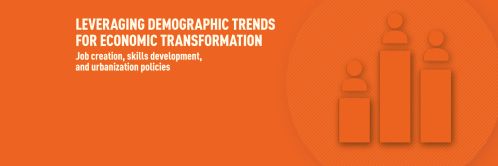Below is a Viewpoint from Chapter 3 of the Foresight Africa 2020 report, which explores six overarching themes that provide opportunities for Africa to overcome its obstacles and spur inclusive growth. Read the full chapter on leveraging demographic trends for economic transformation.
The rapid growth of cities in Africa is presenting the continent with a major opportunity to enhance productivity and living standards. In most parts of the world, rapid city growth has triggered economies of scale and specialization along with knowledge spillovers, thereby boosting productivity. International evidence suggests that doubling of a city’s size boosts income per capita between 3 percent and 8 percent. In fact, countries that are more developed have more urbanization, and countries that switch from slow economic development to rapid economic development also switch from slow urbanization to rapid urbanization.
In contrast, African countries are not making much of the opportunity of urbanization. Only a handful of countries—such as Ghana, Namibia, Rwanda, and Togo—have been relatively successful in translating urbanization into poverty reduction. Notably, the agglomeration of urban economic activity is lower in Africa than elsewhere, while the potential returns in labor productivity growth are the highest. Unfortunately, neither markets nor the policy environment have coordinated decisions that yield satisfactory outcomes in the living or working environment.
International evidence suggests that doubling of a city’s size boosts income per capita between 3 percent and 8 percent.
Markets for land are generally dysfunctional, product markets are fragmented, and weak city planning and limited finance hobble urban development. In fact, very few large African cities have substantial own-source revenues, and tax mandates are often related to having regional government status: consider Kampala, where per capita revenue was $59 for the 2014 fiscal year, much higher than $26 for the rest of the country.
But more broadly, urbanization has been driven by a lack of opportunity in the countryside as agricultural activity has declined and, without the accumulated savings to make significant investments in housing, the default option has been to build shacks. Consequently, 60 percent of the region’s urban population lives in slums. With Africa’s urban population likely to double over the next 25 years, there is an urgent need to make cities livable, productive, and sustainable.
What should be done?
To make cities work for development, African policymakers will need to develop urbanization plans built on the following four proposals:
Raise agricultural productivity: It is difficult to visualize vibrant cities without a well-functioning rural sector. Research suggests that invention, adaptation, and dissemination of new technologies to existing farms is likely boost overall productivity and support a more vibrant structural transformation. A good starting point would be to strengthen national agriculture research and development and innovation systems.
Adopt a well-functioning land market: African leaders need to focus more on the structural foundation of their cities by strengthening institutions governing the transfer, valuation, and use of land. For example, Kenya has one of the least efficient property registration systems on the continent: Lack of registration affects 24 percent of land-owning households in Nairobi. At the same time, the difficulty of registering property has contributed to a growing informal housing supply in urban areas. The capital value forgone by not developing Kibera (1,000 acres of land near Nairobi city center) amounts to $1 billion, $466 per person in greater Nairobi, or 70 percent of Kenya’s GDP per capita in 2014. In Tanzania, only 10 percent of land is registered, and it takes 65 days to transfer property. These inefficiencies reduce incentives for formal land development.
Enhance land use planning: Also, better land use planning will enable cities to put in early and coordinated infrastructure investments that allow for well “formed” urban development. As Africa’s cities clarify land rights and strengthen land use planning, they will encourage economic growth. They will also lay the foundations to expand domestic revenue mobilization, as revenues from appreciation in land values can help finance much-needed urban infrastructure.
Embrace the benefits new technologies offer: Disruptive technologies that combine data with automation present an incredible opportunity to reshape notions of density and economic geography. Add to the mix the gig economy (based on flexible, temporary, or freelance jobs) and sharing economy (involving short-term, peer-to-peer transactions), and we can have vibrant communities that do not need lumpy “grid” infrastructure. In fact, Africa’s cities may be able to leapfrog the current development path and be highly livable, productive, and sustainable. However, this accomplishment will require the basics of land management as well as aggressive investment in human capital.
The Brookings Institution is committed to quality, independence, and impact.
We are supported by a diverse array of funders. In line with our values and policies, each Brookings publication represents the sole views of its author(s).








Commentary
Prerequisites to getting Africa’s urbanization ‘right’
January 21, 2020